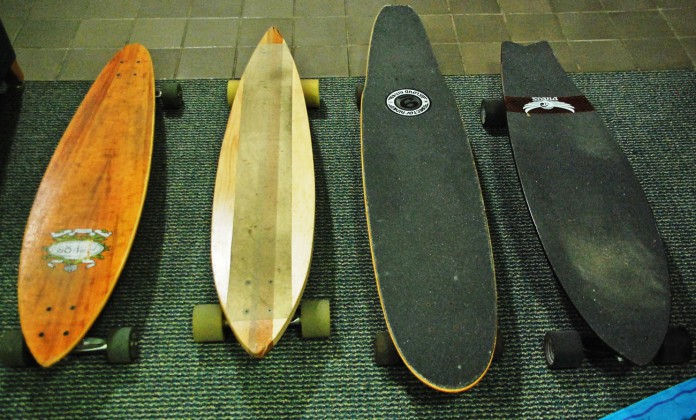Jonny Ainsworth
Staff Writer
Photo by: Hadas Moalem
Shredding, riding the concrete wave, and other such worn out phrases all conjure up the same image of high white socks, plaid shirts and vans shoes. Whatever you want to call it, if you are from California, it is very unlikely you have never tried skateboarding. Before coming to this great state, I must admit that I had no idea how many different variations of skateboards there are. I figured that there can’t be too much past a plank of wood and some wheels, right? I was wrong, so if you are one of the few Cali-dwellers who have never set foot on a skateboard, let’s have a small run-through of the basics.
After visiting Powell Peralta skate shop in downtown Santa Barbara early last week, we received expert advice on skateboarding basics and now have a good idea of how each piece works and how each one fits together.
First there’s the deck. This is filling in the metaphorical sandwich that is the skateboard; it’s the bit you stand on. So far, all of this is fairly integral and necessary. Next, we have the trucks, which attach the wheels to the board. They can be loosened to make turning easier or left tight to avoid unwanted swerves. Last, but not least, there are the wheels: softer wheels give you a much smoother ride and can handle a rougher terrain but tough wheels do well for competition and trick skating. The bearings go between the wheels and the trucks and these are what make your wheel actually spin. Also, the front of the board is the nose, and the back is the tail. Now, let’s hit the boards.
Old-School
These have a wide width and vaguely resemble goldfish crackers. This was the main type of board during the 80’s and early 90’s. The tail is curved but the nose mainly remains flat. Let’s be honest, it’s going to be pretty hard to fall off something that’s as wide as this, thus it is ideal for first-timers or for retro-lovers.
“I ride an old-school board because it’s fast and it gets me to where I need to go. I really just use it to go from A to B,” said Trevor Crown, a first-year Literature student at UC Santa Barbara. “I’ll skateboard around campus if I can but it’s just sometimes easier to bike. Always have some WD-40 around to keep your bearings quick.”
Long Boards
Okay, so you have three guesses at the defining characteristic of a longboard. Did you get it? They’re long. Again, when you have as much surface area as Texas to stand on, this is a good place to start if you’re not too hot on the idea of falling off. They offer a smooth ride on most road surfaces and are a good place to start for intrepid would-be skaters. Just remember, the bigger you are, the more flex your long board will need to be able to support you.
“My friend left me with his long board for a week,” said Hanna Mendoza, a UCSB first-year Political Science major. “It was fun, but I was really intimidated by all the really good skaters on campus. I didn’t want to get in other peoples way. If I was to try and skateboard, I’d definitely use a longboard.”
Mini-Cruisers
These are shorter and smaller skateboards for men or women and are perfect for short journeys around town. Their small size means they aren’t such a burden when you’re not actually skating on them, giving them the capacity to fit beneath a desk or in a closet. However, it also makes it easier to misplace a foot and fall flat on your face. These boards do not do well on the downhill because of their size and they are not for the timid.
Downhill/Slalom
These are long boards with springy decks that corner extremely fluidly. They are designed for downhill skating but are great to just cruise around on, due to the wide trucks and soft wheels. These boards are upgrades to the usual skateboard, and are idyllic for amateurs.
All of the above types of boards are great for cruising around on, yet if you fancy trying to Ollie down a set of twenty steps, you’ll have a hard time. For those of you who can’t resist the allure of trick skating, you need something else.
Trick Boards
Most likely, this is the stereotypical image in your head of a skateboard. The tail and the nose are both curved upwards and the width varies between about 7.5 to 8 inches. These boards usually come with narrow trucks and harder wheels for trick skating but these can be replaced to suit the board more for just cruising.
With skateboarding, size equates to stability. Wide trucks on a skateboard help the board with stability but can make cornering slower. Bigger, softer wheels make for a smoother ride and the bigger the deck, the more room to plant that pesky pushing foot.












Comments are closed.